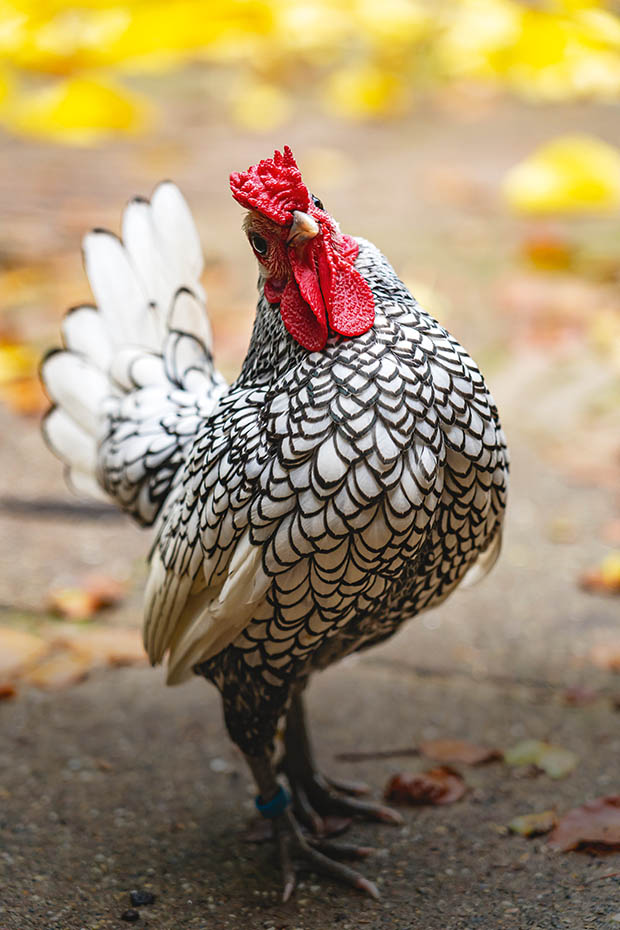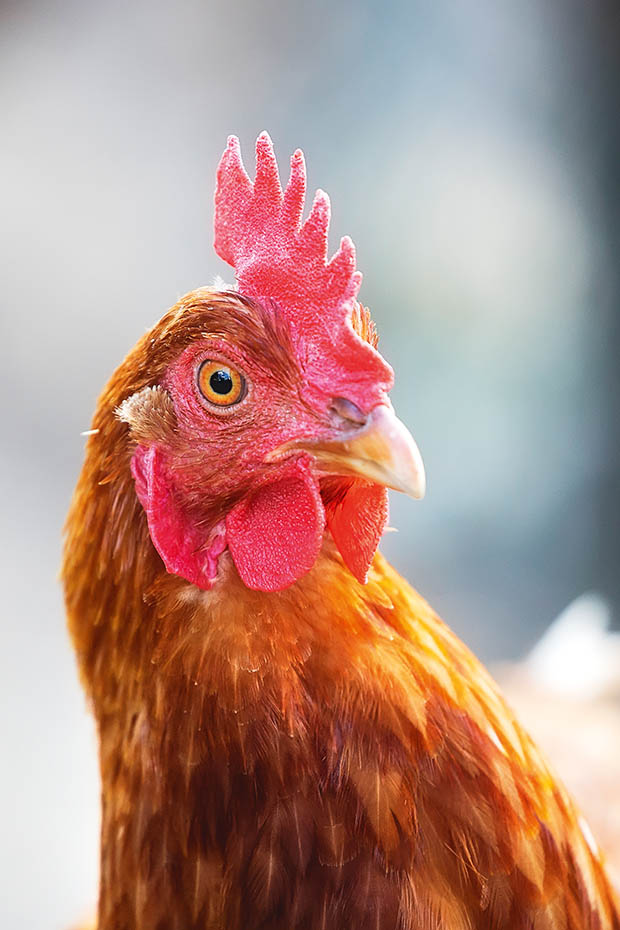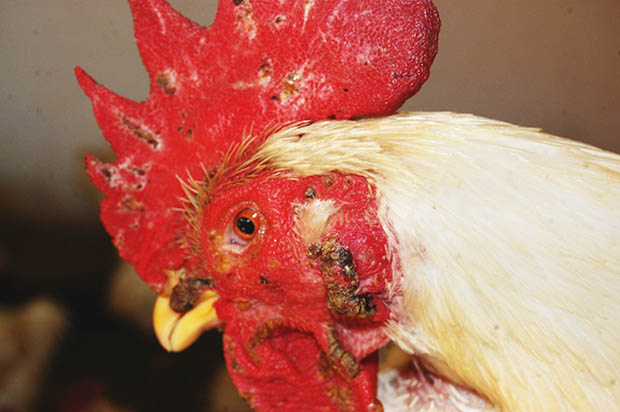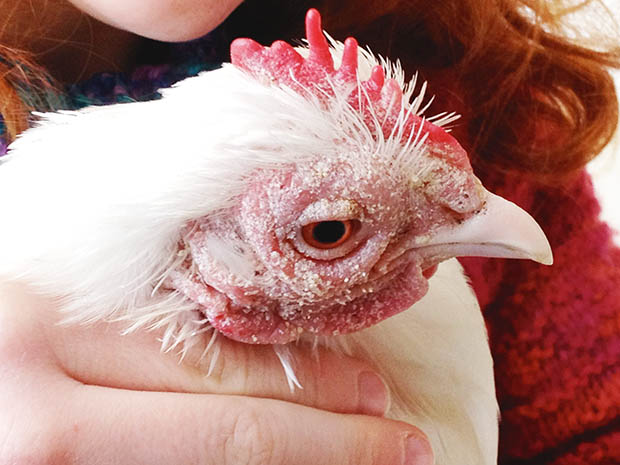9 things you need to know about chicken combs

The appearance of a chicken’s comb can tell you a lot about how it’s feeling.
Words: Nadene Hall
1. It’s all in the name
Scientifically, the chicken is Gallus gallus domesticus – Gallus means ‘comb’ in Latin.
2. It’s how you tell the boys from the girls
The comb is a fleshy growth which starts at the base of the beak and runs towards the back of the head.
In growing male and female birds (and sexually inactive birds), the comb tends to be smaller and paler than an adult hen laying eggs or an adult male producing sperm.
Combs are usually larger and more prominent in males, and it’s often one of the first signs that indicate the sex of a young bird. A cockerel’s face will start to go redder, and its wattles and combs will begin to grow at about 6 weeks of age. Females are slower to grow combs and wattles, which tend to be paler and smaller until they near sexual maturity (16-18 weeks).
It’s more difficult to use combs to identify the sex of dark-skinned breeds, such as Silkies until they’re 20 weeks+.
3. It can help you identify a breed
Comb colour varies depending on the breed, ranging from bright red to dark purple.
The most common style is the single comb (commercial hybrids, many popular heritage breeds). Some combs are more elaborate, such as the Sebright’s rose comb.
Humans have also influenced comb shape, using selective breeding techniques to exaggerate the shape, like the two-pronged comb on the Houdan.

4. The comb’s critically important job
The comb is part of the poultry cooling system. Chickens can’t sweat, so the comb (and wattles, the fleshy appendages below the beak) help with thermoregulation in hot weather. Blood cools as it passes over the comb and wattles, similar to how a radiator works in a car.
Breeds such as Leghorns and Minorcas, which originated in hotter regions like the Mediterranean, have large combs for better cooling. Breeds from cooler climates like North America and England have smaller combs as a large one isn’t necessary, and it’s often a liability in severe cold weather as it can get frostbitten.
5. It’s sexy and hens know it
Males use the size, shape, and colour of the comb and wattles to attract hens. The development of the comb is associated with hormone levels in the body which affect reproduction. Research shows the size of a rooster’s comb and the length of his wattles are key attributes that attract hens to him. The wattles gain a hen’s attention, a flash of colour and movement that make her look at a particular male.
6. The comb knows
The comb can indicate good health, ill-health, and sexual maturity in poultry.
When a hen stops laying eggs – when she goes broody, into a moult, or gets too old – her comb shrivels and becomes paler.
Certain diseases that cause a bird to stop laying can affect the appearance of the comb (eg, pale, colour change) or there may be other symptoms such as scabs.
THE COMB TESTS
1. Press the comb between your finger and thumb so you create a pale spot, then release. The comb should return to its normal colour within 1-2 seconds. If it doesn’t, it’s an indication of anaemia.
2. A shrunken comb is a sign of dehydration, as is a comb that’s suddenly floppy when it’s usually upright.
3 health problems that show up on the comb
FOWL CHOLERA
A common bacterial disease (also known as pasteurella) spread by wild birds, rodents, cats, pigs, and rabbits. Can also be carried on clothing, footwear, and equipment. A fast-moving infection, so often the first sign is sudden death in birds around the point of lay (18-30 weeks+).
Symptoms: listlessness, fever, loss of appetite, ruffled feathers, mouth discharge (may be bloody), nasal discharge, pasty or yellow diarrhoea, lameness, twisted neck. Birds can also develop a chronic infection with swelling in the hock, wing joints, footpad, ear, sinuses, and wattles, or blisters on the breast. Just before death, they’ll have faster than normal breathing and a blue tinge to the comb and wattles.
Treatment: Offer supportive care, such as removing affected birds from the flock, and add a bird electrolyte to their water supply; talk to your vet about treatment options.
Prevention: keep rodents, wild birds, and other carriers out of your coop and run. Don’t let poultry, dogs, and cats share the same area. Quarantine new birds, and practice good biosecurity.
FOWL POX

Photo credit: Lucien Mahin Wikimedia Commons
Also known as avian pox. It’s a virus spread by insect bites to the comb and face, usually seen from October-February. It’s most common in the northern half of the North Island. Birds from there moving to areas further south while they’re incubating the disease may transport it with them. There are two forms, dry pox and wet pox – dry is much more common.
Dry pox symptoms: scabby, wart-like lumps or pustules on the comb, wattles, and face, can quickly become clusters of black scabs, can spread all over the face.
Wet pox symptoms: yellow or white pustules inside the mouth and throat, birds have trouble breathing and swallowing, blindness, mortality can be up to 50%, often due to suffocation.
Other symptoms: depression, lack of appetite, poor growth, weight loss, weakness, drop in egg production.
Dry pox treatment: none – dry pox is slow to spread from bird to bird, so while an individual may recover in 2-4 weeks, it can take a few weeks to go through a flock. Offer supportive care, such as removing affected birds from the flock, and add a bird electrolyte to their water supply. Sometimes secondary bacterial infections may be a problem and antibiotics may help.
Wet pox treatment: none, other than supportive care. Badly affected birds won’t be able to eat or drink, and humane euthanasia is the best option.
Prevention: eliminate areas where mosquitos might breed. Ensure water containers are clean and contain fresh water that’s changed regularly. Prevent puddles and muddy areas forming during the warmer months. Quarantine new birds, and/or don’t buy birds from northern areas during warm months.
FAVUS

Photo credit: Peter Wood
Also known as ‘white comb’ or avian ringworm. A fungal condition that can affect the comb, wattles and other non-feathered areas. Caused by Trichophyton gallinae, the same fungi species that causes ringworm in people.
Symptoms: causes greyish-white patches on the comb that may scale off, making the comb look like it has been dusted with flour. The dusty white areas can thicken up and join to form a wrinkled crust that smells mouldy. Sometimes the crust spreads to other feathered areas creating a honeycomb appearance where feathers are lost. The finer points on a rooster’s comb may also shrivel up and disappear. While some birds may recover on their own after several months, it can also lead to depression, weakness, emaciation, and death.
Treatment: cover the area with a human athlete’s foot treatment cream that contains miconazole (Micreme, Miconazole cream) twice a day until the infection clears or apply Betadine (povidone iodine) once a day until the infection clears – be careful not to get it in their eyes.
NB: Beware, birds can pass this fungi onto humans.
Love this story? Subscribe now!
 This article first appeared in NZ Lifestyle Block Magazine.
This article first appeared in NZ Lifestyle Block Magazine.
